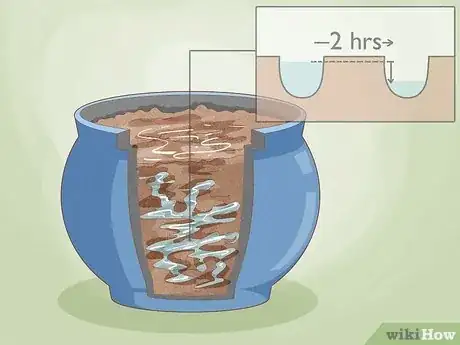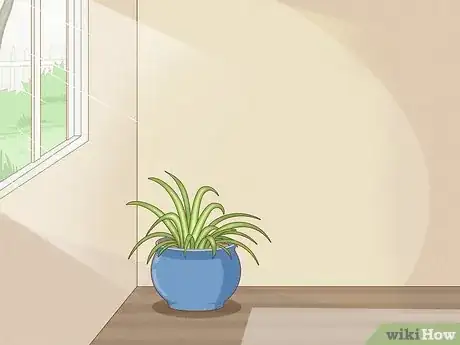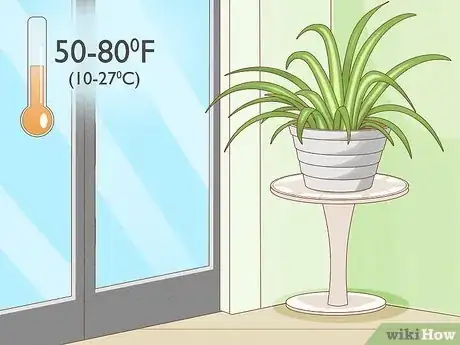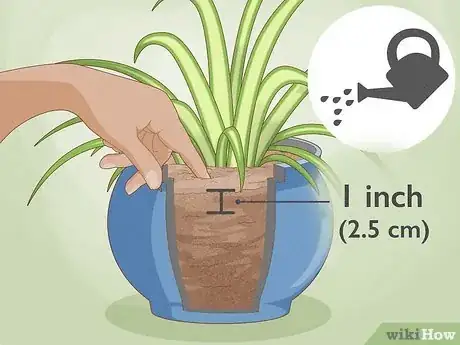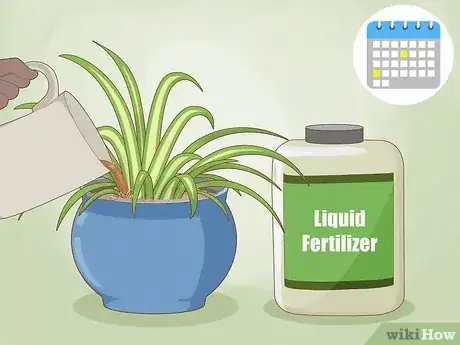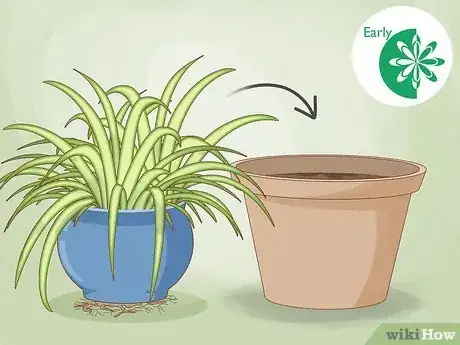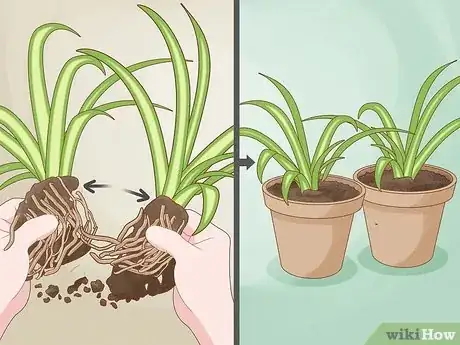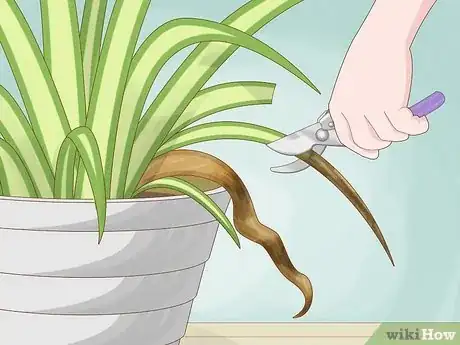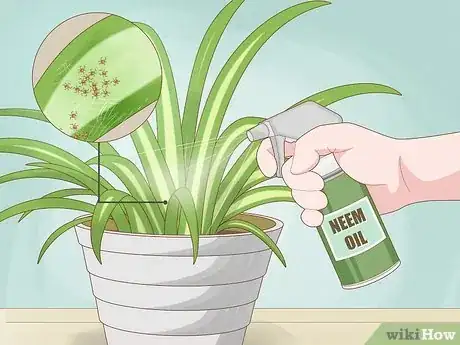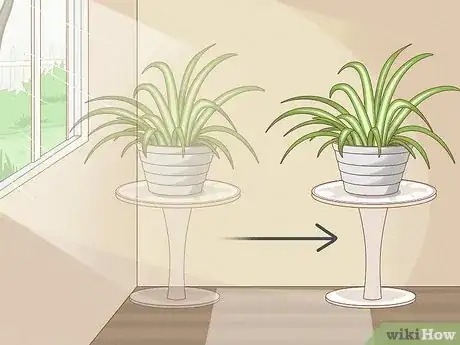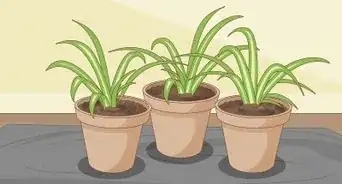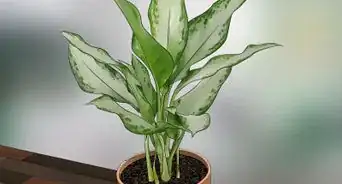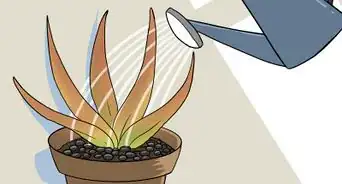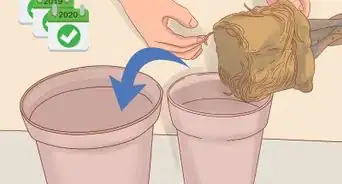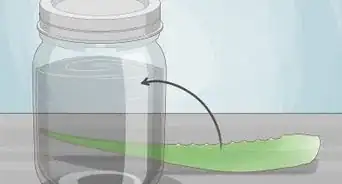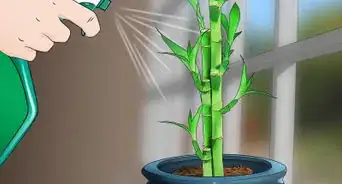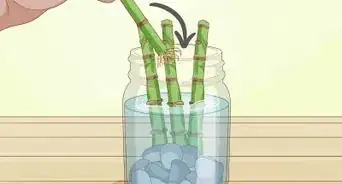This article was co-authored by Maggie Moran and by wikiHow staff writer, Sophia Latorre. Maggie Moran is a Professional Gardener in Pennsylvania.
There are 7 references cited in this article, which can be found at the bottom of the page.
wikiHow marks an article as reader-approved once it receives enough positive feedback. This article has 56 testimonials from our readers, earning it our reader-approved status.
This article has been viewed 1,063,040 times.
Spider plants (chlorophytum comosum) may also be called Airplane plants. Spider plants form arching clumps of grass-like leaves and get their common names from the baby plantlets that form on their dangling stems. They are one of the most adaptable and easy to grow houseplants, so they're perfect for people who don't necessarily have a green thumb!
Steps
Providing the Best Location
-
1Choose well-draining soil or potting medium. If your spider plant is outdoors, plant it in an area with well-draining soil, such as soil that contains sand. If your spider plant is indoors in a pot, select a potting medium like vermiculite or coco coir. Don't fret too much over the soil, as spider plants are very adaptable.[1]
-
2Provide bright, indirect light. Spider plants don't need a ton of natural light, so they do well in bathrooms and bedrooms. They also thrive in windowsills, though they should be set about 12 inches (30 cm) away from south-facing windows during the spring and summer months but please note that they will do well in a north facing window as well. Outdoor plants should have moderate to deep shade during the day, as too much direct sunlight may scorch a spider plant so indirect is better.[2]Advertisement
-
3Maintain moderate and consistent temperature and humidity. If you live in an area where the temperature fluctuates wildly or reaches extremes, your spider plants will do better indoors. They prefer a temperature between 50 °F (10 °C) to 80 °F (27 °C) and can't thrive in outdoor areas with freezing or searing temperatures. Spider plants thrive in humid climates, so place a humidifier in the same room as your spider plant.[3]
Administering Basic Care
-
1Water your spider plant with distilled or purified water. Spider plants in particular are sensitive to the fluoride in tap water. Tap water also leaves behind other minerals that build up and can destroy your plant, so it's important to use distilled or purified water. The water should be kept at room temperature, as cold or hot water can shock your plants and weaken them.[4]
-
2Keep the soil moist but not soggy. Gently poke your finger into the soil to see if it is dry. If the top 1 inch (2.5 cm) or so of soil is dry, it's time to water your spider plant. Watering moderately or once per week during the first year should be sufficient to keep the soil consistently moist, but not overly wet. After the first year, you can water the plant sporadically. Empty excess water from drainage trays immediately if your spider plant is potted.[5]
-
3Fertilize spider plants 1 to 2 times per month during the spring and summer. During the growing season, use a general liquid fertilizer to feed your spider plants. Liquid fertilizers will provide better results than granular fertilizers. Follow the directions on the fertilizer to know how much of the solution to apply to the soil at the base of the plant. Avoid fertilizing spider plants during the winter of if they are outgrowing their pots.[6]
-
4Transplant your spider plant when it outgrows its container. If your spider plant's roots begin to grow through the drainage holes, you'll need to repot it into a larger container in the spring. Be sure to provide fresh potting medium and choose a container with drainage holes to keep the plant from becoming waterlogged.[7]
-
5Propagate large plants. Divide spider plants that are too large by pulling or cutting the root ball into several sections, each with some leaves, and repotting the sections with fresh potting medium. Alternatively, you can pluck off plantlets and root them in a cup of water.[8]
- When propagating the baby plants, it can help to place a cotton ball or wad of napkin in the cup of water to keep the roots from being immersed.
Dealing with Common Problems
-
1Trim dead leaf tips or leaves with scissors. If you notice brown or dead leaves or leaf tips, you should remove them. Snip the tip or leaf off using scissors so that the plant's energy can be directed toward growing healthy leaves. Be sure to use distilled or purified water on your spider plants, as brown leaf tips could indicate mineral buildup in the soil or potting medium.[9]
-
2Treat spider mites with natural insecticides. Signs of spider mites include dull, graying leaves and webby substances on the undersides of leaves. Spray a natural insecticide, like neem oil, on the plant to rid it of spider mites. You can find neem oil at your local garden shop.[10]
-
3Heal blanched leaves by reducing sun exposure. Leaves and stems that are faded or bleached indicate too much sun. If your spider plant is outdoors, transplant it to a shadier location or place a tall plant near it to provide shade. If your spider plant is indoors, move it away from windows so that it receives indirect, rather than direct, sunlight.[11]
Expert Q&A
-
QuestionHow much sun does a spider plant need?
 Maggie MoranMaggie Moran is a Professional Gardener in Pennsylvania.
Maggie MoranMaggie Moran is a Professional Gardener in Pennsylvania.
Home & Garden Specialist Spider plants do enjoy bright light, however, they need to be protected from too much direct sunlight. They flourish in partial shade.
Spider plants do enjoy bright light, however, they need to be protected from too much direct sunlight. They flourish in partial shade. -
QuestionWhy are the tips of my spider plant leaves turning brown?
 Maggie MoranMaggie Moran is a Professional Gardener in Pennsylvania.
Maggie MoranMaggie Moran is a Professional Gardener in Pennsylvania.
Home & Garden Specialist The most common reason behind brown leaves is overwatering or letting the foliage rest in water. The soil of spider plants should be left to dry slightly between waterings,
The most common reason behind brown leaves is overwatering or letting the foliage rest in water. The soil of spider plants should be left to dry slightly between waterings, -
QuestionIs a spider plant indoor or outdoor?
 Maggie MoranMaggie Moran is a Professional Gardener in Pennsylvania.
Maggie MoranMaggie Moran is a Professional Gardener in Pennsylvania.
Home & Garden Specialist They can be grown either inside or outside. It's best to begin a seedling indoors, then they can easily be moved outside.
They can be grown either inside or outside. It's best to begin a seedling indoors, then they can easily be moved outside.
Warnings
- Spider plants are poisonous to cats, though other animals don't seem to be affected. It would be wise, however, to prevent all pets, including birds, from eating them.⧼thumbs_response⧽
References
- ↑ https://plantcaretoday.com/spider-plant-care.html#What-Soil-Type-Do-Airplane-Plants-Grow-Best-In
- ↑ https://plantcaretoday.com/spider-plant-care.html#What-Light-Does-Chlorophytum-Grow-Best-In
- ↑ https://plantcaretoday.com/spider-plant-care.html#Airplane-Plants-Like-Consistent-Moderate-Temperatures-Best
- ↑ http://www.freedrinkingwater.com/water-education3/3-water-plants.htm
- ↑ http://www.apartmenttherapy.com/spider-plant-tips-for-growing-care-and-propagating-234822
- ↑ http://www.apartmenttherapy.com/spider-plant-tips-for-growing-care-and-propagating-234822
- ↑ http://www.apartmenttherapy.com/spider-plant-tips-for-growing-care-and-propagating-234822
- ↑ http://www.apartmenttherapy.com/spider-plant-tips-for-growing-care-and-propagating-234822
- ↑ http://www.gardenloversclub.com/houseplants/spider-plant/growing-spider-plants/
About This Article
To care for a spider plant, place it in a humid spot that gets indirect sunlight, like in a bathroom. Water your spider plant with distilled or purified water since they can be sensitive to the fluoride in tap water. You want the soil your plant is in to be consistently moist but not soggy. If you notice your spider plant's roots growing through the drainage holes in the bottom of the pot, transfer it to a larger pot so it has room to grow. To learn how to deal with pests or dead leaves on your spider plant, read on!
